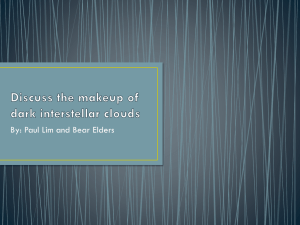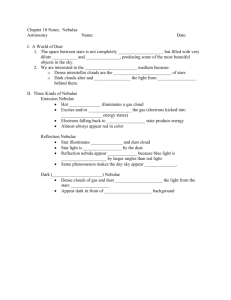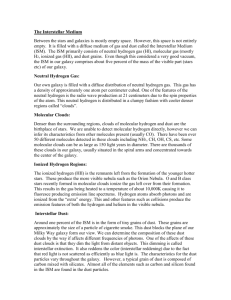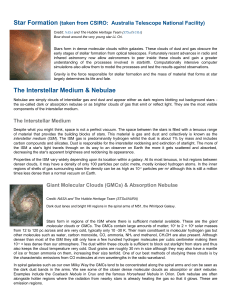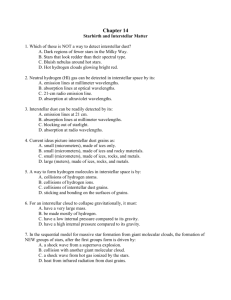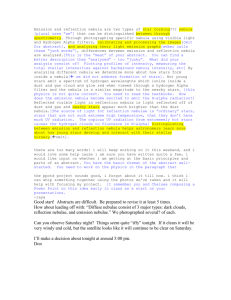Lecture 13
advertisement
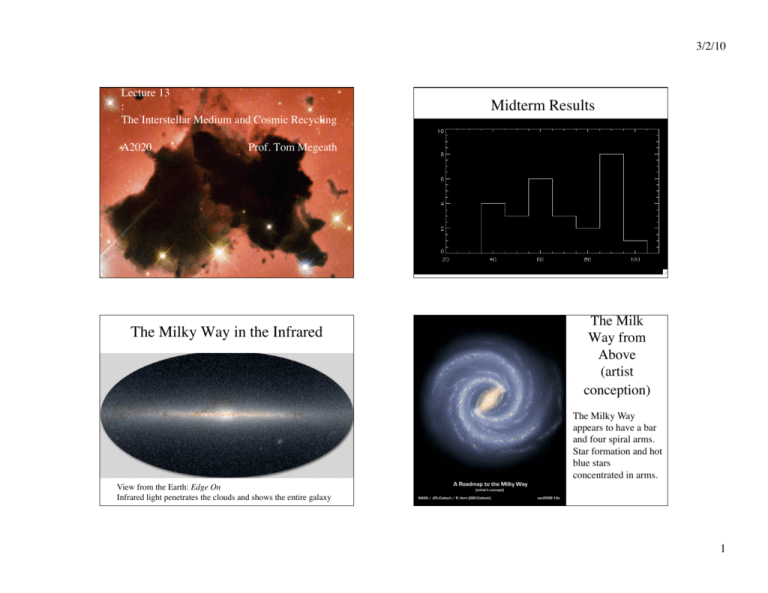
3/2/10 Lecture 13 : The Interstellar Medium and Cosmic Recycling A2020 Midterm Results Prof. Tom Megeath The Milky Way in the Infrared The Milk Way from Above (artist conception) The Milky Way appears to have a bar and four spiral arms. Star formation and hot blue stars concentrated in arms. View from the Earth: Edge On Infrared light penetrates the clouds and shows the entire galaxy 1 3/2/10 The Interstellar Medium NGC 7331: the Milky Way’s Twins The space between the stars is not empty, but filled with a very low density of matter in the form of: • Atomic hydrogen • Ionized hydrogen • Molecular Hydrogen • Cosmic Rays • Dust grains • Many other molecules (water, carbon monoxide, formaldehyde, methanol, etc) • Organic molecules like polycyclic aromatic hydrocarbons How do we know the gas is there? Review: Kirchoff Laws Remainder of the Lecture Foreground gas cooler, absorption 2. The multiwavelength Milky Way 3. Cosmic Recycling (or cooler blackbody) 1. How we observe and study the interstellar medium Absorbing gas hotter, emission lines (and blackbody) If foreground gas and emitting blackbody the same temperature: perfect blackbody (no lines) Picture from Nick Strobel’s astronomy notes: www.astronomynotes.com 2 3/2/10 Observing the ISM through Absorption Lines • We can determine the composition of interstellar gas from its absorption lines in the spectra of stars • 70% H, 28% He, 2% heavier elements in our region of Milky Way Picture from Nick Strobel’s astronomy notes: www.astronomynotes.com Emission Lines Emission Line Nebula M27 Emitted by atoms and ions in planetary and HII regions. Planetary Nebula M27 Green: Ionized Oxygen Red: Hydrogen Gas ionized by central white dwarf 3 3/2/10 Observing Ionized Gas: Bremstrahlung Bremstrahlung from M27 Emission Line Created when electrons fly by protons. Depending on temperature, Bremstrahlung can emit any wavelength, from radio to X-ray or visible wavelengths. Typical temperature of gas 10,000 to 1 million Kelvin Bremstrahlung http://www.nrao.edu/whatisra/mechanisms.shtml Observing Ionized Gas: Synchroton Radiation Magnetic fields are present in the Galaxy, when electrons move throught these fields, they produce synchrotron radiation. Often produced in Supernova remnants Supernova Remnant Cassiopeia A X-ray (emission line, bremstrahlung, synchrotron) Radio map (VLA), synchrotron 4 3/2/10 Observing a radio emission line from atomic hydrogen: The 21 cm line (1428 MHz) 21 cm emission in the galaxy M33 Visible Light 21 cm http://www.nrao.edu/whatisra/mechanisms.shtml Emission from Molecules Molecular Clouds in Our Galaxy Rotation produce radio wavelength rotation. Vibrations produce infrared radiation. Most clouds to cold for vibrations. Need polar molecules, like CO (carbon monoxide). Most common molecule, H2, is not polar and is hard to detect Image Courtesy of Tom Dame 5 3/2/10 Interstellar Masers Dust in the Milky Way Galaxy LASER: Light Amplified by Stimulated Emission of Radiation MASER: Microwave Amplified by Stimulated Emission of Radiation Monochromatic: light all of a single wavelength and in phase. MASERS occur naturally in giant stars, molecular clouds, and disks around black holes in other galaxies Molecules seen with masers: H2O (water), H2CO (formadehyde), NH3 (ammonia), SiO (silicon monoxide), OH (Hydroxyl), HCN (Hydrogen Cyanide) Image Courtesy of Tom Dame Interstellar Dust Interstellar Reddening • Tiny solid particles of interstellar dust block our view of stars on the other side of a cloud • Long-wavelength infrared light passes through a cloud more easily than visible light • Particles are < 1 micrometer in size and made of elements like C, O, Si, and Fe • Observations of infrared light reveal stars on the other side of the cloud 6 3/2/10 Absorption and Scattering by Dust Grains Reflection Nebulae Very little dust: Pleiades Cloud of Dust Lots of dust: Orion Reflection Blue Light Yellow Light Red and Infrared Light When we see starlight scattered by dust grains, this is a reflection nebula. Organics Molecules in Space Polycyclic Aromatic Hydrocarbons, Formic Acid, Acetylene, Methanol, EthylAalcohol, and many more detected in molecular clouds. 7 3/2/10 NGC 7331: the Milky Way’s Twins The Milky Way’s Twin in the Infrared (Image from the Spitzer space telescope) Note the dark regions are glowing! Interstellar Medium has many components. The Milky Way in Visible Light Molecular gas (20 K) Cold atomic gas (100 K) Hot atomic gas (10,000 K) Ionized gas (10,000 - 1 million K) Mixed in this is dust!!! View from the Earth: Edge On 8 3/2/10 Infrared Visible We observe star-gas-star cycle operating in Milky Way’s disk using many different wavelengths of light Infrared light reveals stars whose visible light is blocked by gas clouds Radio (21cm) X-rays X-rays are observed from hot gas above and below the Milky Way’s disk 21-cm radio waves emitted by atomic hydrogen show where gas has cooled and settled into disk 9 3/2/10 IR (dust) Radio (CO) Radio waves from carbon monoxide (CO) show locations of molecular clouds Long-wavelength infrared emission shows where young stars are heating dust grains Gamma rays show where cosmic rays from supernovae collide with atomic nuclei in gas clouds Gamma rays show where cosmic rays from supernovae collide with atomic nuclei in gas clouds 10 3/2/10 Interstellar Medium has many components. Molecular gas (20 K) - seen in CO maps - Cold atomic gas (100 K) Hot atomic gas (10,000 K) - both seen in 21 cm maps - Ionized gas (10,000 - 1 million K) -seen in radio continuum and X-ray maps- Mixed in this is dust - seen in dust absorption How is gas recycled in our galaxy? Star-gas-star cycle Recycles gas from old stars into new star systems 11 3/2/10 Low-Mass Star Summary Steps of Star Formation 1. Main Sequence: H fuses to He in core 2. Red Giant: H fuses to He in shell around He core 3. Helium Core Burning: He fuses to C in core while H fuses to He in shell Molecular Cloud Protostar 300,000 years 4. Double Shell Burning: H and He both fuse in shells Star with disk Not to scale! Planetary Nebulae 5. Planetary Nebula leaves white dwarf behind Binary Stars and Planetary Nebula • Double-shell burning ends with a pulse that ejects the H and He into space as a planetary nebula • The core left behind becomes a white dwarf 12 3/2/10 Enrichment of ISM by low to intermediate mass stars: Model of the Helix Nebula Planetary Nebulae End point of low and intermediate mass stars Can contain 40% of the mass. Contain newly created Carbon, Nitrogen and Oxygen. Helix Nebula Dust and molecules are found in outer reaches of nebula 4 light years across Joe Hora Life Stages of High-Mass Star 1. Main Sequence: H fuses to He in core Enrichment by High Mass Stars: Wolf Rayet Stars Evolved high mass stars with powerful winds, lose mass at 10-5 solar masses per year (10-14 for our sun), winds enriched in Helium, Nitrogen, Carbon and Oxygen. Thus massive stars enrich ISM even before they supernova. 2. Red Supergiant: H fuses to He in shell around He core 3. Helium Core Burning: He fuses to C in core while H fuses to He in shell 4. Multiple Shell Burning: Many elements fuse in shells Not to scale! 5. Supernova leaves neutron star behind 13 3/2/10 Enrichment by High mass stars: Eta Carinae (a hypergiant) Hubble space telescope show star ejecting a cloud of gas and dust. Supernova remnant cools and begins to emit visible light as it expands New elements made by supernova mix into interstellar medium Enrichment by High Mass Stars: Supernovae X-rays from hot gas in supernova remnants show emission lines from reveal newly-made heavy elements Radio emission in supernova remnants is from particles accelerated to near light speed Cosmic rays probably come from supernovae 14 3/2/10 OB Association: High Mass Stars form in Associations with tens to hundreds of stars Superbubbles: When 10 to 100 massive stars act together through winds and supernovae, sweeping up the surrounding gas in a bubble Orion Infraed N44 is the Large Magellenic cloud, a nearby galaxy λ [microns] = 2900 /T [K] Eridanus Superbubble Galactic Fountains Red emission: hydrogen emission line 15 3/2/10 Multiple supernovae create huge hot bubbles that can blow out of disk Galactic Fountains Gas clouds cooling in the halo can rain back down on disk The Local Bubble Gas Cools Summary of Galactic Recycling • Stars make new elements by fusion • Dying stars expel gas and new elements, producing hot bubbles (~106 K) • Hot gas cools, allowing atomic hydrogen clouds to form (~100-10,000 K) • Superbubbles may sweep up and compress hydrogen clouds, creating molecular clouds. • Spiral arms may also sweep up and compress hydrogen clouds, creating molecular clouds. • Creation of dense clouds shields gas from UV photons from starlight permiting molecules to form, making molecular clouds (~30 K) • Gravity forms new stars (and planets) in molecular clouds 16 3/2/10 Overview The Interstellar Medium How gas and dust emit and absorb light in the ISM What the ISM in our galaxy looks like at many wavelengths Cosmic-Recycling: Star formation - stellar evolution - winds, planetary nebula and supernova High mass stars create bubbles and fountains in our galaxy. Big Bang made 75% H, 25% He – stars make everything else 17
